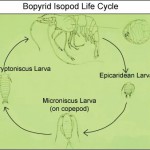
Kevin’s wonderful post on the Giant Isopod inspired me to post on a topic I have long pondered. Frequent readers of DSN know that I am fond of Sylvia Earle and the topic of body size. Honestly, it is not just body size is all matter of size related issues. A roadside trip can be quickly diverted by the world’s largest ball of yarn or North America’s largest biscuit. Mmm…biscuits, but I digress. What I want to discuss, and I use this word specifically as after 10 years contemplation I seem no closer to an answer, is why the Giant Isopod is, well, giant?
Mosely noted in 1880
Other [animals] attain under them gigantic proportions. It is especially certain crustacea which exhibit this latter peculiarity, but not all crustacea, for the crayfish like forms in the deep sea are of ordinary size. I have already referred to a gigantic Pycnogonid [sea spider] dredged by us. Mr. Agassiz dredged a gigantic Isopod eleven inches in length. We also dredged a gigantic Ostracod.
For over a 125 years, scientists have contemplated the extreme size of Bathynomus giganteus. Do other isopods attain these sizes? Gigantism is also known in the isopod Serolis but enlargement comes from flattening that increases the effective surface area. B. giganteus appears unique in its extreme gain in bulk.
Why the increase in size? Timofeev (2001) proposed that deep-sea gigantism, for all crustaceans, is a consequence of larger cells sizes obtained under cold temperatures, as has proposed for other groups (e.g. Van Voorhies 1996). In crustaceans, bathymetric gigantism may also in part reflect decreases in temperature leading to longer lifespans and thus larger sizes in indeterminate growers (Timofeev 2001). However, despite little changes in temperature beyond the thermocline, deep-sea invertebrates including isopods continue to show changes in body size. Alternatively, Chapelle and Peck (1999 and 2004) demonstrated that maximum potential size was significantly correlated with oxygen concentration in the related amphipods. It is suggested this relationship arises because the amount of oxygen available controls the amount of sustainable tissue. This has been shown experimentally in which cell size and cell number both increase with increasing oxygen concentration (Frazier et al. 2001, Peck and Chapelle 2003). Larger sizes in gastropods are also found at more oxygenated sites in the deep sea (McClain and Rex 2001). However, giant isopods are known from the Gulf of Mexico deep where oxygen concentrations are low.
Kevin also brought up another interesting point….
B. giganteus is a scavenger (3, 5, 6), but some suggest it is also a facultative predator (3, 6). Specimens in aquaria have survived 8 weeks between feedings (5) and it speculated that this may be an adaptation for carrying its brood, which would be severely impacted by a full stomach (3). Further support for this hypothesis are the large quantities of lipid reserves in the hepatopancreas (14) and fat bodies (2) of this isopod.
Alternatively, the larger size also increases fasting potential because greater fat reserves can be maintained. Larger size also confers a greater foraging area, important for either a scavenger or a predator. Both of these are important adaptations in the food-limited deep sea.
Of course all of this is speculative and it remains unclear why Bathynomus is unique among arthropods. Perhaps is size is simply a random walk in evolution and is nonadaptive. Gould noted in reference to another body size pattern, Cope’s Rule…
One would think that issues so fundamental, and so eminently testable, had been conclusively resolved long ago-except for a perverse trait of human psyche. We tend to pick most ‘notable’ cases out of general pools, often for idiosyncratic reasons that can only distort a proper scientific investigation
Is this case for the Giant Isopod? But perhaps the most interesting question is why the Giant Isopod is not larger?






In regards to the last question, the maximum reported size of Bathynomus giganteus is likely to be an artifact of our sampling.
On the contrary, Briones-Fourzan and Lozano-Alvarez have done most of the ecology of this isopod in the Gulf of Mexico and have amassed a large sample size (almost 1600 individuals – Barradas-Ortiz et al. 2003), yet their max. size was 36.3 cm, about the size of the one trying to rip my throat out above.
More morphometric analysis needs to be done correlating size to depth, oxygen concentration, temperature etc. using Canonical correspondence analysis or something similar to tease apart the variables limiting its size. It would be great to get growth rate data, I wonder if one could follow it in aquaria and measure adult growth after each molt.
Ok, stream of consciousness of a sort here:
I get the idea that Gould’s quote is making, but a giant, deep-sea isopod as a result of an evolutionary random walk? I’m skeptical of that one. It would be nice to know how their growth rate compares to other isopods. Speaking of other isopods, are there any other deep-sea varieties? Or is Bathynomus giganteus the only one. If there are others, are they also larger than normal? Conversely, are there other (non-deep-sea) gigantic isopods out there and if so, where do they live? Instead of looking at gigantism as a whole or even within arthropods, what if we focus only on isopods? What is the pattern then?
I like the larger-size-for-times-of-famine idea. What is the resource availability for these guys? Is there always something to scavenge or prey upon? Is there seasonal or other variation? Is it predictable?
sorry I can’t offer answers, just more questions.
(BTW it’s totally out of character and irrelevant, but I think isopods are gross, along with millipedes, and the giant versions are really gross. Nightmarish even. *chills*)
Actually, the idea of a random walk is mine, size doesn’t necessarily need to be advantageous just not disadvantageous. Gould’s point is the same one you make which what is the trend among all isopods (there are lots of others)and the futility of focusing on just one. As far as other isopods some definitely do get larger (but not others) but none like Bathynomus a very unique case.
What is the resource availability for these guys? Is there always something to scavenge or prey upon? Is there seasonal or other variation? Is it predictable? Definite variation and patchiness through space and time so the fasting potential becomes important.
The genus Bathynomus currently comprises of 11 species, the last one described in 2004 from Thailand. 8 of these have vertical ranges below Craig’s Definition of Deep (CDD). There many types of isopods in the deep sea and they are very common. They range in size from minute to large and different body forms and life histories. I’ll try to highlight some of the more obscure and interesting ones in future.
Isoods are very common in all environments, even freshwater and terrestrial. Check out the world database of isopods at: http://www.nmnh.si.edu/iz/isopod/
Looking at gigantism within the isopods is a great idea, one I would like to pursue in the future if I had the time and resources. In fact the genus Bathynomus is great place to start since the vertical range of the genus is 22-2140m and many species have wide horizontal distributions. Unfortunately, getting sample sizes of lots of different species from different depths to attain the statistical power to test hypotheses is the limiting factor.
Resource availability for B. giganteus is probably very intermittent. Some days a nice tuna falls on your lap, other days nothing. If they hang around methane seeps or deep-sea coral reefs, they potentially have the opportunity to be “regular” to the scene and scavenge or be a facultative predator on other inhabitants of seeps or reefs.
There may indeed be seasonality in the deep sea in terms of the amount of biomass that falls down from the surface during productive seasons versus non-productive seasons. This could definitely have an effect on the observed seasonality of reproduction in B. giganteus. More experimentation is needed to get at the correlation though.
Do they make good pets? I would love one of those guys!
I believe that researchers at Texas A&M have them in aquaria. I have a paper on that I can send if you are interested
I want to find out that can deep sea isopop be sea food?
Another way to look at this would be to ask why land isopods are so tiny!
I have an idea – perhaps unfounded – that body size relates to competition between predator and prey. The larger you are, the fewer the things can eat you, and more things are edible. I think the pill bugs in my back yard are tiny so they can hide easily. That’s obviously not an option for the giant isopod, so maybe being huge is good if you are walking around on the ocean floor with no cover.
So two questions:
Is the ocean floor really open where it lives?
And …. does anything eat a giant isopod? Besides people, who eat anything.
Does anybody know what they taste like?
I do not propose that i know much about these things but i am excell at analitical thinking. Sometimes the direction an nature of our questions can be limited by learning. sometimes it takes the unknowing eye to ask the question that knowledge can obstruct. every creaature on this amazing planet of ours developed from the first cingle celled organisms. we are all cousins so to speak. we can look to other animals bugs, birds, fish, plants, viruses, germs, bacteria, all the living things in this world started at the same place. This evolution also extends to things we dont even realize at times.why even the computer programs we use today are mirrored after the behavioral patterns in the wild called algorithems if i spelled that right. Dinosaurs are a perfect example of the genetic marker that we visually see in the fossils of reptiles. why were dinosaurs so big? answer your question an i suspect youll have the answer for that one an vice versa. If you look at the behavior of all of nature an you will understand why an how the animals of today an the plants too came to be. If we look at our own psyiology an its seperate parts an how they mirror other systems in nature an u will start to see it. Our circulatory systen is like a tree. remove a tree from the ground with its roots intact an you see a mirror of our circulatory system. our skin is like a different version of the skin of a tree where the living part is on the out side bark is the epidermas. an so forth. there is coral that looks like the human brain. An on an on it will go as with every creature alive there related systems can be found echoed all across nature. some creatures from seperate species display a symbiotic relationship. like the birds around an elephant or rino. or fish that groom other fish. or the bacteria in our stomachs. cingle celled organisms with different traits would share a sybiotic relationship with one another say like if one ate one kind of mineral an gave off a byproduct that the other needed then u would find they would reproduce together until they seemingly became one genetically connected. complex systems can also demonstrate this kind of behavior but it becomes less frequent with the complexities of the systems an compatibility less frequent. exception to this and a purfect example would be human reproduction. think of all that people face to reproduce. Lol! Two different systems but very similar ones so much that reprodutction from the union of two different genetic structures joining as on to form a new one. genetic defects are an example where the systems are different in a maner that causes them to not function together an die. Viruses an the way they attack our bodies is a smaller organism trying to invasively introduce its genetics in our system. The forced symbiosis is not always fatal to the smaller organisms sometimes its fatal to the larger ones. it has a negative impact like a parasite. like heartworms to a dog. If heart worms werent fatal an harmful but impacted both in a positive way they would over time be permenantly joind in their genetic make up. like what we have become. You will find a genetic trait that is shared between gigantic species like the arthropidic nature of just the one u are describing in the boney plated arthropidic form as ur water bug. An if you can corelate the similar environmental or dietary or preditorial vs. scavengers an see which ones the are the similar factors for them all an i suspect u will have ur answer. stuydy the research of others to find similar answers. an remember sometimes its just as einestine says its relative to the perspective that its viewed from. Nothing is written in stone an new information can bless or destrow old ideas an views but none are infaliable an theres always more to learn. my blessing is the ability to remember almost everything that i c. so when i read or watch something i never forget it. i love information!